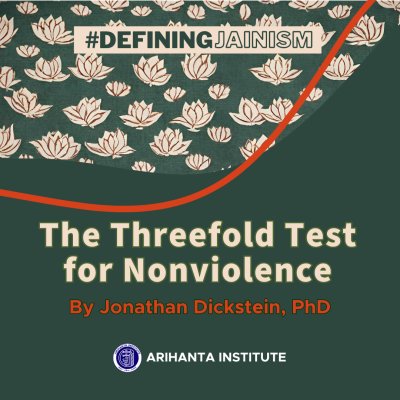
The Sanskrit word ahiṃsā is most often translated as “nonviolence,” but it is also rendered as “nonharming” and “noninjury.” The latter translations are arguably more precise insofar as an act of hiṃsā (“violence”) typically involves the deliberate exercise of physical or psychological harm. While deliberateness and intent do matter in Jainism, the basic conception of hiṃsā does not require malintent or any type of intentionality. That being said, henceforth I translate ahiṃsā as “nonviolence” and hiṃsa as “violence” to follow convention and avoid confusion.
Ahiṃsā is the principal vow (vrata) in Jainism, a pledge made by all Jains—ascetic and lay—to refrain as much as possible from committing acts of violence. In Jainism, violence might be described as any act of body, speech, or mind that inflicts duḥkha (suffering/unpleasantness) upon another sentient organism. An alternative description might assert that violence refers to any such act than negatively impacts the prāṇas (vitalities) of a sentient organism. Regardless of how “injury” itself is defined, the result of violence is injury of one sort or another to a sentient organism. But what does it mean to commit an act of violence? What qualifies as acting in violation of the vow of ahiṃsā?
Jain texts present a threefold test for nonviolence, a test not unknown to other śramaṇa (renouncer, literally “striver”) traditions. Jainism holds that committing an act of violence involves:
Direct participation (kṛta): Performing an act of violence oneself
Examples: Killing a sentient organism; binding, mutilating, or inflicting some other nonlethal injury upon a sentient organism; starving, depriving, or otherwise neglecting a sentient organism
Indirect participation (karitā): Causing another person to perform an act of violence on one’s behalf
Examples: Hiring someone to kill a sentient organism; purchasing items, such as animal flesh, that require and thereby promote the further harming and/or killing of sentient organisms
Tacit participation (anumata): Explicitly or implicitly approving of the performance of violence in one’s vicinity
Examples: Not physically intervening when acts of violence are occuring in one’s presence; not speaking in opposition when acts of violence are occurring in one’s presence
(See Ācārāṅga Sūtra 1.1.1.5; Tattvārtha Sūtra 6.8/6.9; Ratnakaranda Śrāvakācāra 53, 72)
The third test of nonviolence, tacit participation (anumata), is noteworthy from the perspective of Engaged Jainism. While the argument could be made that ethical restraints—e.g., not eating meat, not eating at night, not traveling unnecessarily, not pursuing particular professions— “engage” the world by means of disengaging with particular aspects of it, as restraints they function dissimilarly from proactive interventions. Perhaps not as karmically catastrophic as direct and indirect participation in violence, the tacit approval of acts of violence through noninterventions of body, speech, or mind could still satisfy as violations of the vow. One long-established Jain proactive intervention is the panjrapole, or animal sanctuary, an institution that both rescues and cares for animals to end their exposure to further anthropogenic violence, such as confinement, isolation, mutilation, manipulation, and slaughter.
Interestingly, this threefold test is not unique to the Jain tradition. A pre-Common Era Buddhist text from the Pāli Canon, the Dhammika Sutta from the Khuddaka Nikāya of the Sutta Piṭaka, states “He [a layperson] should not kill a living being, nor cause it to be killed, nor should he incite another to kill. Do not injure any being, either strong or weak, in the world” (Sn 2.14.19). In addition, the mid-first millennium century CE Yoga Sūtras of Patañjali includes: “Negative thoughts are violence, etc. They may be [personally] performed, performed on one’s behalf by another, or authorized by oneself” (YS 2.34). These texts serve as two examples from adjacent religious traditions of what appears to be a pan-Indic standardization of a threefold framework for the scope of violence and nonviolence.
Of course, determining what does and does not count as “tacit participation” (as well as who decides) is no simple chore, nor is determining the extent to which one is obligated to intervene to address the violence around them. Nevertheless, the threefold test for nonviolence fosters vigilance in one’s faithfulness to the vow, keeping the adherent ready and willing to exercise both restraint and proactivity for the wellbeing of others.

